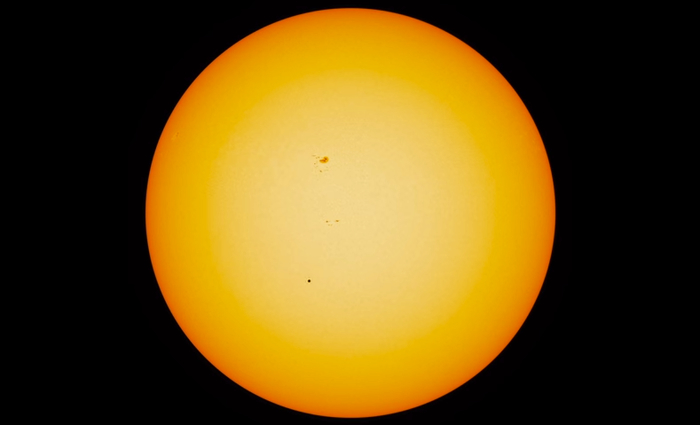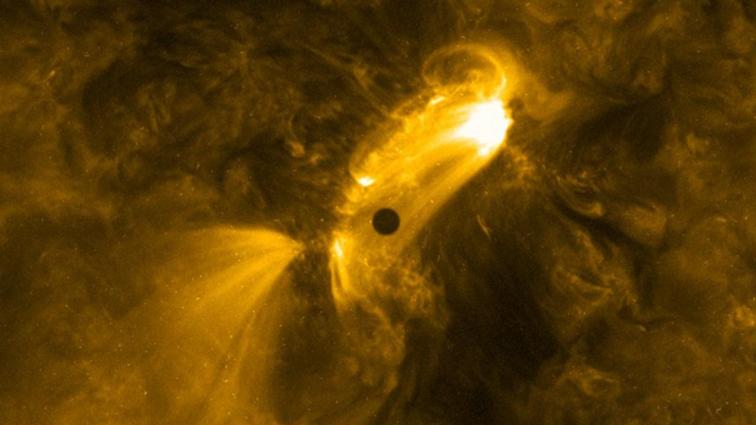Lab plays role in striking view of Mercury transit
 (Download Image)
The planet Mercury is seen in silhouette, lower third of image, as it transits across the face of the sun Monday, May 9, as viewed from Boyertown, Pennsylvania. Mercury passes between Earth and the sun only about 13 times each century, with the previous transit taking place in 2006. Photo courtesy of Bill Ingalls/NASA
(Download Image)
The planet Mercury is seen in silhouette, lower third of image, as it transits across the face of the sun Monday, May 9, as viewed from Boyertown, Pennsylvania. Mercury passes between Earth and the sun only about 13 times each century, with the previous transit taking place in 2006. Photo courtesy of Bill Ingalls/NASA
Around 13 times per century, Mercury passes between Earth and the sun in a rare astronomical event known as a planetary transit. The 2016 Mercury transit occurred on May 9 between roughly 4:12 a.m. and 11:42 p.m. PDT.
NASA's stunning video of the transit of Mercury across the sun was made possible in part by work done by Lawrence Livermore scientists. Regina Soufli, a member of the Physics Division, led her LLNL team, including Jeff Robinson, Eberhard Spiller, Sherry Baker and Jay Ayers, and collaborated with Eric Gullikson of Lawrence Berkeley National Laboratory's Center for X-Ray Optics, Reflective X-ray Optics, LLC and other institutions, on the design, development, fabrication and calibration of the multilayer mirrors used in the extreme ultraviolet (EUV) telescopes of NASA's Solar Dynamics Observatory (SDO) mission.
The SDO multilayer mirrors act as reflective lenses and are responsible for capturing the images and movies of the sun produced by SDO at seven extreme ultraviolet (EUV) wavelengths, including those shown in NASA’s video of the Mercury transit.
The SDO EUV multilayer mirrors were calibrated and tested by Soufli at Lawrence Berkeley's Advanced Light Source Beamline 6.3.2 before being launched into space in 2010. Since then, SDO telescopes have been recording solar activity in exquisite spatial, spectral and temporal resolution 24 hours a day, 365 days a year, including Monday's transit.
Launched in 2010, SDO is NASA's most advanced solar mission to date. It observes the sun's surface, called the photosphere, and its atmosphere, called the corona. Scientists use SDO data to study and elucidate the sun's extremely complex and dynamic magnetic field, and its plasma and related phenomena, including intense solar activity such as solar flares and coronal mass ejections. These phenomena directly impact Earth's upper atmosphere and nearby space environments.
This project was sponsored at LLNL by the Smithsonian Astrophysical Observatory and by Lockheed Martin Corporation, for NASA.
Contact
 Anne M. Stark
Anne M. Stark
[email protected]
(925) 422-9799
Related Links
NASA Solar Dynamics ObservatoryLLNL finds a place in the sun
Lab scientist receives NASA award for the Solar Dynamics Observatory mission
LLNL multilayer mirrors fly on NASA’s Solar Dynamics Observatory
Regina Soufli elected fellow of Optical Society
Tags
Space Science InstitutePhysical and Life Sciences
Featured Articles








